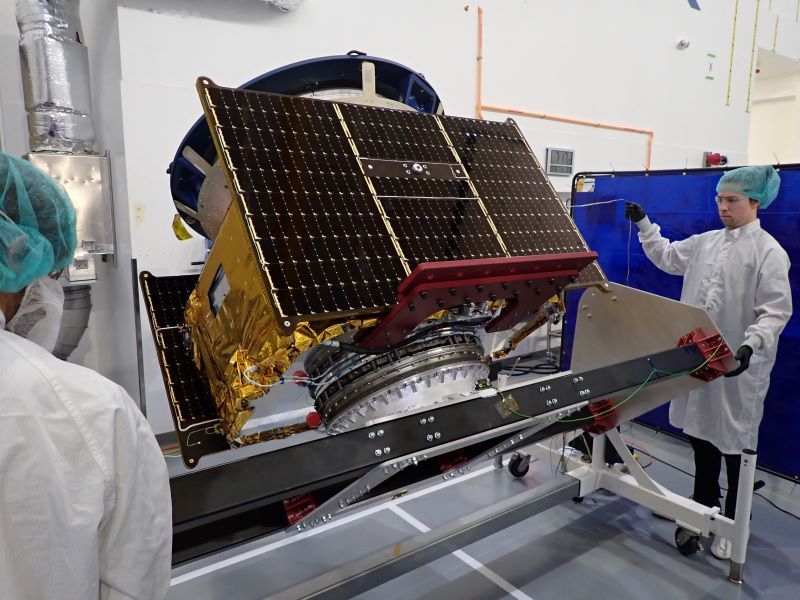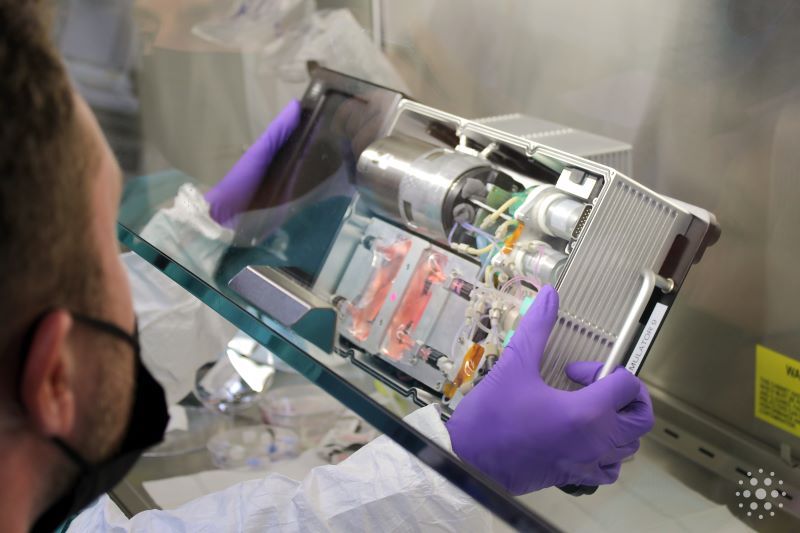The space race is moving on to manufacturing, with more companies looking at establishing an industrial complex in outer space. From an orbital vantage point, factories, laboratories, farms, energy generation and storage together with communications could provide for much of humanity’s material requirements.
The advantages of manufacturing and research presented by microgravity, dust-free sterile environments, and the room available in space are beginning to outweigh the disadvantages of the cost and logistics.
Some experts believe that one day almost all industrial activity could be off-planet, from where it can do the least amount of harm to the terrestrial climate and the ecosystem.
Market development
Despite the advantages, Mike Cruise, emeritus professor at the University of Birmingham believes the development of significant commercial infrastructure in space is still decades away. He says, “Space remains a technically hostile environment while launching payloads and returning products to Earth is a physically expensive business.”
However, territorially driven political agendas or a major unexpected find of useful minerals in space could drive innovation. “A space war between major powers could change the picture significantly,” Cruise says.
Factories in space expert and author Erik Kulu believes that asteroids will almost certainly be mined in the future, but that high levels of investment will be needed before the process becomes economically worthwhile. However, in-space manufacturing offers a potential shortcut.
“It will start with bringing materials from Earth, manufacturing a new or better type of material in microgravity, and then bringing the product back down,” says Kulu. “Once that is established, that company could become a customer to other emerging space industries. For example, if a new startup can bring raw materials from asteroids cheaply, then they immediately have potential customers.”
NASA R&D
Space manufacturing started in 2014 at NASA, with a 3D printer on the International Space Station (ISS) with Made-in-Space. In 2019, NASA announced a strategy to develop a Low Earth Orbit (LEO) economy that included in-space manufacturing to stimulate non-NASA demand for commercial space stations. In 2020, the agency formalized this support by establishing a recurring budget for a growing portfolio of In Space Production Applications awards.
NASA’s OSAM (On-orbit Servicing, Assembly, and Manufacturing-One) project serves as an indication of how difficult and costly in-space manufacturing and operations are. The space agency delayed the first phase (OSAM 1) in October this year. The program will now launch in 2026. Part of its mission is an on-orbit demonstration when it will approach a satellite, grapple it, and remove some Mylar plastic with a cutting tool.
OSAM-2, which was formerly known as Archinaut-1 (see ATI December 2019) was canceled in September 2023. According to NASA, a lot of work had been done on the ground for the program and valuable data and lessons were gained for future mission use. Elsewhere, the US agency recently selected Lockheed Martin to demonstrate in-space component joining and inspection technologies for structural, electrical, and fluid systems. The capability aims to reduce risk and advance the maturity and reliability of in-space assembly.

NASA and its Space Technology Mission Directorate consider needs and objectives for In-Space Servicing, Assembly, and Manufacturing (ISAM) within several larger categories. Each of these plays a role in the assembly of large assets. Limitations in the size of the launch vehicle and the payload fairing make assembly necessary.
“If we can take raw materials up with us and do assembly there it takes away the size constraints,” says Trudy F Kortes, director of technology demonstration missions for NASA. “Some of the things being considered by our technologists are semiconductors and fiber optics manufactured in microgravity. By doing that, you can have fewer defects, better performance, and cost improvements.
“Manufacturing in a space environment for in-space use and building things at the site where it will be used also means we do not have to carry spare parts for long-term missions, for example.”
NASA has two robotic-based projects developing software and hardware that will be able to autonomously assemble a variety of functional structures. The Precision Assembled Space Structure project and the Automated Reconfigurable Mission Adaptive Digital Assembly Systems program aim to enable the construction of habitat structures, large antennae arrays, and even a spaceport. NASA engineers also recently developed builder robots capable of autonomously working together and assembling small modular 3D printed parts, called voxels, capable of making a variety of structures.
Kortes describes NASA’s work in the field of ISAM as “push technology”, in that the technology developed will prove its benefits in the future, in ways that may not currently be apparent. She believes that by applying a “build it and they will come” attitude, push can be transformed into pull technology.
Testing methods
NASA is currently developing three in-space manufacturing technologies: electronics, welding / additive manufacturing (AM), and recycling. These all require testing.
In-space electronics technology development uses ground-based testing and parabolic flights to simulate the space environment and increase technology readiness levels. In-space welding uses frictionless flat floor experiments which simulate frictionless motion in microgravity, thermal vacuum chamber testing to simulate both the thermal and vacuum environments of space simultaneously and parabolic flight testing for simulating varied gravity conditions for short periods of time. In addition, radiation tests and orbital flight experiments further the technology readiness level of ISAM technology.
Currently, ground-based testing processes are essentially the same as conventional methods and use functional data, visual inspection, and non-destructive evaluation to determine the quality of a product. “Once in space, all testing equipment must be modified for the environment, and a mixture of computational modeling and machine learning must be applied to reduce the number of physical tests necessary to qualify a manufacturing process,” NASA said.
Kortes sees proving the case for projects as a particular challenge for in-space technology development, alongside resourcing the move from demonstration to operational capability. “One demonstrates the technology at a system level and in a relevant environment to reduce risk,” she says.
European work
The European Space Agency (ESA) is involved in various projects relating to in-space manufacture. Examples of ongoing or recently completed projects from the agency’s Technology Development Element (TDE) program include the Imperial project, which built a 3D printer capable of on-orbit polymer printing in a controlled environment.
Also, part of the TDE program was the Recycling of Hardware for the Moon and Martian Settlement project and the In-space manufacturing of linear parts for the booms and solar array structures program which involved Airbus.
Other ESA R&D has fallen under its Discovery Innovation Program and has developed additive manufacturing processes, machines and assembly methods. Projects include “Podium”, which demonstrated additive manufacturing in a vacuum and the Startiger initiative on “Factories in Space” to demonstrate on the ground how on-orbit manufacturing and assembly of antenna structures would work.
Meanwhile, ESA’s OSCAR (In-Orbit, Servicing, Construction and Recycling technologies) project is looking at the technologies required for the robotic assembly, servicing and recycling of very large structures in orbit.
The ESA has completed its Clean Space’s OMAR (On-orbit Manufacturing Assembly and Recycling) initiative, which consists of an internal concurrent design facility study, followed by four individual studies on mission architecture for on-orbit manufacturing, assembly and recycling of satellites, the system-level design of a servicing station, design principle for satellites manufactured and assembled on orbit and a concept for on-orbit manufacturing and assembly of a large antenna reflector.
The research agency is also preparing to launch a metal 3D printer demonstrator, which will be the first metal AM system in orbit, in a consortium led by Airbus.
Testing methods
ESA’s technology development activities for in-space manufacturing focus on assessing whether the developed technologies are relevant for application in the targeted environment. This is achieved by operating them in various conditions that simulate the environment of interest. Depending on the available budget for the activity, this can consist of testing the manufacturing system in different orientations to verify the independence of the gravity vector, at different pressure levels using vacuum chambers, and in various temperature ranges.
More representative testing by parabolic flights, using sounding rockets, and on orbital platforms such as the ISS becomes possible with an increased budget, explains Advenit Makaya, an advanced manufacturing engineer at ESA.
This will be the case for the metal 3D printer technology demonstrator which is expected to be launched at the end of 2023.
ESA is also looking into developing reliable modeling tools for in-space manufacturing processes, which will complement and sometimes reduce the testing effort and increase understanding of how the processes operate in the space environment.
Development of in-space manufacturing capabilities will have the benefit of accelerating the exploration and exploitation of space. Makaya says “With in-space manufacturing, we can build larger structures – larger solar arrays to give more power for satellites. For antennae reflectors, an increase in size can mean higher data throughput for telecommunications, with associated business benefits. For space telescopes, more data can be collected.
“In the longer term, a manufacturing in space ability will also mean repairing and recycling, helping to reduce the need for launches and even the recycling of space debris, contributing to better sustainability in the space activities.”
Orbital Opportunities
The new space race will not just be a race but a collaborative effort, although competition between superpowers will be a factor in driving innovation. Partnerships will be of vital importance in surmounting financial and logistical obstacles.
“As space stations become more commercial in nature, there’s a greater responsibility to create more literal trade space for more cooperations and less competition,” says Sonty.
Kortes points to the Artemis Accords as a great example of international collaboration, of which she says the current NASA leadership is a very strong supporter.
Furthermore, in-space manufacturing requires the development of novel technologies and materials that address the challenging environment of space. These will all need testing and then inspection, monitoring on Earth while in orbit, and then into the farther reaches of space according to viability.
Meanwhile, commercial opportunities are expected to provide most of the impetus. Kulu points out that the world needs new revenue sources from space activities to make them more economically sustainable “The economic drive is a major force, which we have to take into account,” he says.
Drug-making in orbit
California, USA-based Varda is building one-time-use manufacturing satellites with economical re-entry capsules onboard. For its first four missions, the company is collaborating with Rocket Lab. The first mission was launched on June 12 of this year, and its next missions will launch in 2024 and 2025.
Varda makes pharmaceuticals in space. “For our first few missions we focus on a melt/cool process,” says Varda co-founder, Delian Asparouhov. “Over time, we will expand capabilities to include solvent-based processes. Today we heat and cool a material, in the future we will heat, cool, and mix.
“In microgravity the primary mode of transport for mesoscopic chemical systems shifts from convective transport to diffusive transport, which is far less entropic. This can have implications for processes, such as the crystallization of biologics.”

The innovative company plans to continue to upscale to manufacturing larger satellites, increasing cadence and capabilities.
Health research in space
Space Tango specializes in automated microgravity solutions for data, biotech, and manufacturing. Since Space Tango’s first commercial launch in 2017, the company has facilitated over 260 research payloads on the International Space Station (ISS) with the aim of addressing global health challenges.
Space Tango’s CEO, Sita Sonty says, “This work will continue as we continue to evolve our product line to support a higher throughput of sustainable, commercially viable products for humanity.
“Changes in biological systems in microgravity provide opportunities for insight into mechanisms of disease, drug therapy targets, and manufacturing opportunities that could change the industry.

Key research is helping to improve the understanding of and develop new health solutions addressing bone and muscle loss, immune dysfunction, accelerated aging, cardiovascular deconditioning, as well as 3D tissue and
organ engineering.





